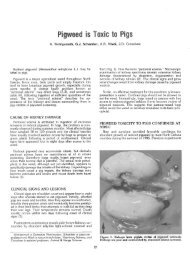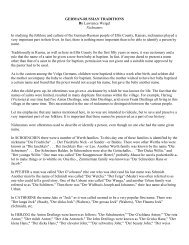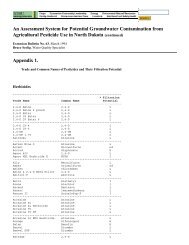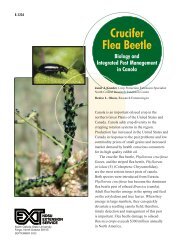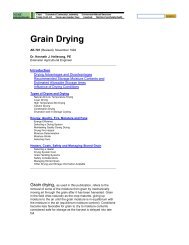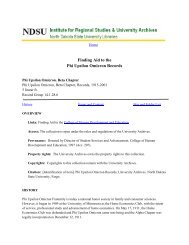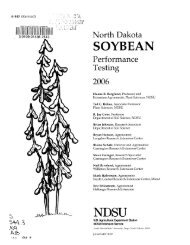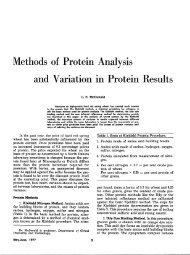germans from russia in fort collins, 1900-2000 - Libraries
germans from russia in fort collins, 1900-2000 - Libraries
germans from russia in fort collins, 1900-2000 - Libraries
You also want an ePaper? Increase the reach of your titles
YUMPU automatically turns print PDFs into web optimized ePapers that Google loves.
WORK RENDERS LIFE SWEET: GERMANS FROM RUSSIA IN FORT COLLINS<br />
two congregations: Bethlehem Evangelical<br />
Lutheran and German Evangelical<br />
Congregational.<br />
While Bethlehem Evangelical Lutheran<br />
Church was officially organized on March<br />
20, 1904, church records date back to 1902,<br />
the first year of large-scale German-Russian<br />
settlement <strong>in</strong> Fort Coll<strong>in</strong>s. At first Rev.<br />
Manntuefuel, an it<strong>in</strong>erant preacher, conducted<br />
services <strong>in</strong> various homes <strong>in</strong> Buck<strong>in</strong>gham<br />
and Andersonville. Then, <strong>in</strong> late 1903, the<br />
Fort Coll<strong>in</strong>s Colorado Sugar Company<br />
offered the congregation a small outbuild<strong>in</strong>g<br />
to use as a church. Peter and Cora Anderson<br />
donated to the fledgl<strong>in</strong>g congregation two<br />
lots, now <strong>in</strong> the 500 block of Tenth Street <strong>in</strong><br />
Andersonville. The congregation moved the<br />
former sugar company outbuild<strong>in</strong>g to the lots<br />
and, as Venita Schneider describes it, “remodeled<br />
[the build<strong>in</strong>g] <strong>in</strong>to a church with a high<br />
pulpit approached by a w<strong>in</strong>d<strong>in</strong>g stairs, patterned<br />
after European pulpits.” 64 The church<br />
survived the flood that devastated the area<br />
around it and, little more than a week after the<br />
disaster, the congregation <strong>in</strong>stalled Rev. W.<br />
John Siefkes as pastor.<br />
The Bethlehem Evangelical Lutheran<br />
congregation cont<strong>in</strong>ued to grow and by 1913<br />
required a larger church. On the corner of<br />
Whedbee and Olive Streets, men of the<br />
church began to excavate the basement of the<br />
new worship space with shovels and teams of<br />
horses. Each family was assigned to haul with<br />
horse-drawn wagons loads of limestone <strong>from</strong><br />
the quarries at Stout (now beneath Horsetooth<br />
Reservoir) to the construction site. The old<br />
church <strong>in</strong> Andersonville was dismantled and<br />
the lumber reused for the basement ceil<strong>in</strong>g<br />
and the back entrance of the new church. The<br />
structure was completed <strong>in</strong> 1914.<br />
However, beg<strong>in</strong>n<strong>in</strong>g <strong>in</strong> the 1930’s, a<br />
schism developed between first- and secondgeneration<br />
Germans <strong>from</strong> Russia. The wound<br />
proved too deep for even their strong faith to<br />
heal. Church elders at Bethlehem <strong>in</strong>sisted on<br />
conduct<strong>in</strong>g services and religious education<br />
<strong>in</strong> German. George K. De<strong>in</strong>s, <strong>in</strong> a 1979 oral<br />
history <strong>in</strong>terview, recalled that the church<br />
also cont<strong>in</strong>ued seat<strong>in</strong>g “<strong>in</strong> the Russian-style,<br />
with the men on the right and the women on<br />
the left.” 65 But the pastor of the church, Rev.<br />
Conrad H. Becker, and other second-generation<br />
families sought to worship <strong>in</strong> English<br />
and sit as a family. Add<strong>in</strong>g to the problem<br />
was the fact that Becker, who was not a<br />
German <strong>from</strong> Russia, assisted Sykes <strong>in</strong> writ<strong>in</strong>g<br />
Second Hoe<strong>in</strong>g. Its 1935 publication met<br />
with strong condemnation <strong>from</strong> the older<br />
generation of Germans <strong>from</strong> Russia who controlled<br />
the church. On June 24, 1938, Becker<br />
and <strong>fort</strong>y-six families separated <strong>from</strong><br />
Bethlehem to form the American Lutheran<br />
Church. Nam<strong>in</strong>g their new church<br />
“American” is a tell<strong>in</strong>g symbol of the second<br />
generation’s desire to assimilate <strong>in</strong>to the culture<br />
around them. The new congregation conducted<br />
services at a Unitarian church on the<br />
corner of Mulberry and College. They purchased<br />
a build<strong>in</strong>g at Mulberry and Mathews<br />
and, most recently, moved to a new build<strong>in</strong>g<br />
at 301 East Stuart Street. The congregation<br />
changed its name to Tr<strong>in</strong>ity Lutheran Church<br />
on May 24, 1965. Bethlehem cont<strong>in</strong>ued to<br />
conduct services <strong>in</strong> German until 1955. Six<br />
years later, the orig<strong>in</strong>al congregation relocated<br />
aga<strong>in</strong> to a larger structure at 1200 South<br />
Taft Hill Road. Members of the congregation<br />
renamed themselves Shepherd of the Hills <strong>in</strong><br />
1962. 66<br />
The other congregation identified with<br />
the Germans <strong>from</strong> Russia began <strong>in</strong> much the<br />
same way as the Bethlehem Evangelical<br />
Lutheran. Members of the German<br />
Evangelical Congregational Church met <strong>in</strong><br />
houses and available build<strong>in</strong>gs until<br />
November 1903 when Rev. Paul Buckhard<br />
SWCA Environmental Consultants Page 18



